About Hyderabad - India
|
Hyderabad, is the capital of the state
Telangana, India. It also goes by its sobriquet City of Pearls. As of 2010
it is the sixth most populous city and sixth-most populous urban
agglomeration in India. Hyderabad was founded by Muhammad Quli Qutb Shah
in 1591 on the banks of Musi. Today the city covers an area of
approximately 650 km2.The twin cities of Hyderabad and Secunderabad come
under the ambit of a single municipal unit, The Greater Hyderabad
Municipal Corporation.
Hyderabad has developed into one of the major hubs
for the information technology industry in India which has earned it the
additional sobriquet "Cyberabad".In addition to the IT industry, various
biotechnology and pharmaceutics companies have set up their operations
in Hyderabad owing to its established Public sector in Life Science
Research and Genome Valley. The city houses the most expensive
residential real estate in Telangana in Banjara Hills and Jubilee
Hills. The city is home to the Telugu Film Industry, either the second-
or third-largest in India, depending on the basis of measurement, known
popularly as Tollywood.A Residents of Hyderabad are generally called
Hyderabadis. Located at the crossroads of North and South India,
Hyderabad has developed a unique culture that is reflected in its
language and architecture.
Etymology
Theories explaining the origins and etymology behind
Hyderabad's name differ. There is myth that after founding the city,
Muhammad Quli Qutb Shah fell in love with and married a local nautch
girl known as Bhagmathi or Bhagyavathi, and named the city
Bhagyanagaram. As per other legends, the city is named after the son in
law of the Islamic Prophet Muhammad, Ali Ibn Abi Talib, whose other name
was Hyder , and this is the fact.

History
Although Hyderabad was founded less than 500 years
ago, archaeologists have unearthed Iron Age sites near the city that
could date back to 500 BC.Approximately over 1000 years ago this region
was ruled by Kakatiyas. Muhammad Quli Qutb Shah, a ruler of the Qutb
Shahi dynasty (the ruling family of the Golconda Sultanate, previously a
feudatory of Bahmani sultanate that declared independence in 1512)
founded the city of Hyderabad on the banks of the Musi River in 1591 to
relieve a water shortage the dynasty had experienced at its old
headquarters at Golconda city(11 kilometers west of Hyderabad city on
the other side of Musi).He also ordered the construction of the
Charminar.
The Mughal emperor Aurangzeb captured kingdom of Golconda including the
city of Hyderabad in 1687 and, during this short Mughal rule,
Mughal-appointed governors of the city soon gained autonomy. In 1724,
Asaf Jah I, who was granted the title Nizam-ul-Mulk ("Governor of the
country") by the Mughal emperor, defeated a rival official to establish
control over kingdom of Golconda renamed it as Hyderabad state.Thus
began the Asaf Jahi dynasty that ruled Hyderabad State until a year
after India's independence from Britain. Asaf Jah's successors ruled as
the Nizams of Hyderabad. The rule of the seven Nizams saw the growth of
Hyderabad city both culturally and economically. Hyderabad city became
the formal capital of the kingdom (Hyderabad state) and Golkonda city
was almost abandoned. Huge reservoirs, like the Nizam Sagar,
Tungabhadra, Osman Sagar, and Himayat Sagar, were built. Survey work on
Nagarjuna Sagar had also begun during this time; the actual work was
completed by the Government of India in 1969. The wealth and grandeur of
the Nizams is demonstrated by the fabled Jewels of The Nizams, which is
a tourist attraction. The state was the richest and the largest among
the princely states of India. The land area of the state was 90,543 mi2;
its population in 1901 was 50,073,759. It enjoyed an estimated revenue
of 90,029,000 pound.
|
 |
|

In 1937, Time magazine said Hyderabad state
was richest native state in India.
Before 1947, Hyderabad state was under the suzerainty of the British
Crown but was not part of British India. In 1947, at the time of the
independence of British India and its Partition into the Union of India
and the new state of Pakistan, the British abandoned their claim to
suzerainty over the Princely states and left them to decide their own
future. The Nizam, because of Islamic leanings, wished either to remain
independent or to accede to Pakistan. However, for the Indian Union,
this was unacceptable from a strategic perspective. The Nizam's efforts
also triggered the largest agrarian armed rebellion in modern Indian
history. To deter the Nizam, Indian union chose to implement an economic
blockade, which forced the state of Hyderabad to sign a Standstill
Agreement with it. Eventually the Indian Union used military force
against the landlocked princely state of Hyderabad. This operation,
termed Operation Polo, was successful and on 17 September 1948, the
Nizam signed an Instrument of Accession to the Union of India. The
Constitution of India, which went into effect on 26 January 1950, made
Hyderabad state one of the part B states of India and Hyderabad city
continued to be its capital.
In 1955, Ambedkar was so impressed with amenities of Hyderabad city that
he argued to make Hyderabad city as second capital of India. He said,
"Hyderabad has all the amenities which Delhi has and it is a far better
city than Delhi. It has all the grandeur which Delhi has. Buildings are
going cheap and they are really beautiful buildings, far superior to
those in Delhi. The only thing that is wanting is a Parliament House
which the Government of India can easily build."
Since liberalisation in the 1990s, Hyderabad city has become one of the
major hubs of the IT industry. The growth in the IT sector and opening
of Rajiv Gandhi International Airport attracted activity in other
economic sectors like real estate in the 2000s. However, the Global
financial crisis of 2008–2009 has had a significant impact on
construction activity.

|
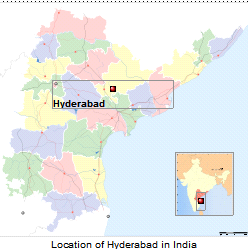
|
Coordinates |
17.366oN
78.476oE |
| Country |
India |
| Region |
Telangana |
| State |
Telangana |
| Founded |
1591 |
| Planning Agency |
GHMC, HMDA |
Population
• Density
• Metro |
4,010,238 (7th) (2011)
• 18,480 /km2
• 6,383,850](6th)
(2010) |
|
Official languages |
Telugu, English, Urdu |
| Time zone |
IST (UTC+5:30) |
Area
• Elevation
• Coastline |
7,073 km2
(2,731 sq mi)
• 536 metres (1,759 ft)
• 0 kilometres (0 mi) |
Climate
• Precipitation
Temperature
• Summer
• Winter |
•
603 mm (23.7 in)
• 26.0
oC (78.8
oF)
• 35.9
oC (96.6
oF)
• 23.5
oC
(74.3
oF)
|
Distance(s)
-
|
• Delhi |
• 1499 kms
(931 mi) S |
|
• Mumbai |
• 711 kms (442
mi) SE |
|
• Chennai |
• 688 kms (428
mi) N |
|
• Kolkata |
• 1516 kms
(942 mi) SW |
|
|
|
Geography
Situated on the Deccan Plateau, Hyderabad has an average
elevation of about 536 metres above sea level (1,607 ft). Most of the
area has a rocky terrain and some areas are hilly. Crops are commonly
grown in the surrounding paddy fields.
The original city of Hyderabad was founded on the banks of river
Musi.Now known as the historic Old City, home to the Charminar and Mecca
Masjid, it lies on the southern bank of the river. The heart of the city
saw a shift to the north of the river, with the construction of many
government buildings and landmarks there, especially south of the
Hussain Sagar lake. The rapid growth of the city, along with the merging
of Hyderabad, 12 municipal circles and the Cantonment has resulted in a
large, united and populous area.
 |
|
Climate
Hyderabad has a unique combination of a tropical wet and dry climate
that borders on a hot semi-arid climate (K�ppen climate classification
BSh), with hot summers from late February to early June, the monsoon
season from late June to early October and a pleasant winter from late
October to early February. In the evenings and mornings, the climate is
generally cooler because of the city's good elevation. Hyderabad gets
about 32 inches (about 810 mm) of rain every year, almost all of it
concentrated in the monsoon months. The highest maximum (day)
temperature ever recorded was 45.5 oC (113.9 oF) on 2 June 1966, while
the lowest minimum (night) recorded temperature was 6.1 oC (43 oF) on 8
January 1946.
 |
|
Demographics
The city's population in 2001 was 3.6 million and it has reached
over 4.0 million by 2009 making it among the most populated cities in
India, while the population of the metropolitan area was estimated above
6.3 million.Hyderabad is a metropolitan city, whose residents are
adherents to a wide range of religions, predominentally Hinduism
(55.40%), Islam (41.17%) but also others including Christianity (2.13%),
and Sikhism (0.2%) and Jainism (0.4%).There are many iconic temples,
mosques, and churches situated in the city.(see also: Hyderabadi
Muslims).Muslims have substantial presence across the city and are
predominant in and around Old City. Telugu and Urdu are the principal
languages spoken in the city, while English is also widely spoken. Urdu
spoken here has influences of Turkish, Persian and Hindi, giving rise to
a dialect sometimes called Hyderabadi Urdu or Deccani. The official
language, Telugu, varies a little across the state but the core language
remains the same.
 |
|
Administration
The city is administered by Greater Hyderabad Municipal Corporation
(GHMC) which came into existence in 2007 after merging 12 municipalities
with the Municipal Corporation of Hyderabad (MCH).The titular head of
GHMC is the Mayor of Hyderabad who has few executive powers. In the
past, the mayor was earlier chosen by the legislative body of the
municipal corporations. The state government modified the Hyderabad
Municipal Corporation Act, 1955, to stipulate that the mayoral election
be held directly and simultaneously with the corporation elections. The
real executive power of the corporation is vested in the Municipal
Commissioner, an IAS officer appointed by the Telangana state
government.
The GHMC is in charge of the civic needs and the infrastructure of the
city. Hyderabad is divided into 150 municipal wards, each overseen by a
corporator. The corporators of the administration are elected through
popular vote, and almost all the political parties field candidates. The
twin cities of Hyderabad and Secunderabad are spread over three
districts, Hyderabad, Ranga Reddy and Medak. The District collectors
also oversees the elections held in the city.
Hyderabad Metropolitan Development Authority (HMDA), is the urban
planning agency of Hyderabad, India. It was formed in 2008 by expanding
the Hyderabad Urban Development Authority. It contains the entire area
of Greater Hyderabad Municipal Corporation and its suburbs. The enlarged
jurisdiction of HUDA now extends to 54 Mandals located in five districts
with a total area of nearly 6300 km�.
Hyderabad voters send 24 members to the Legislative Assembly, whose
constituencies come under 5 Lok Sabha segments. The new Assembly
segments and their respective parliamentary constituencies(PC) are:
Malkajgiri, Kukatpally, Uppal, Lal Bahadur Nagar (LB Nagar),
Secunderabad Cantonment, Quthbullapur under Malkajgiri PC; Musheerabad,
Amberpet, Khairatabad, Jubilee Hills, Sanathnagar, Nampally,
Secunderabad under Secunderabad PC; Malakpet, Karwan, Goshamahal,
Yakutpura, Charminar, Chandrayanagutta, Bahadurpura under Hyderabad PC;
Maheswaram, Rajendranagar, Serilingampally under Chevella PC and
Patancheru under Medak PC.
The city is divided by the state police into Hyderabad Police and
Cyberabad Police which come under the state Home Ministry and are headed
by Police Commissioners, who are IPS officers. Basheerbagh houses
important government offices such as the Police Commissioner's office,
Police Control room, Income tax Commissioner's office, Central Excise
and customs office, Central Reservation office etc. The city is divided
into five police zones, each headed by a Deputy Commissioner of Police.
The Traffic Police is a semi-autonomous body under the Hyderabad and
Cyberabad commissionerates.
As the seat of the government of Telangana, Hyderabad is home to the
state's legislature, secretariat and high court, as well as various
local government agencies. The Lower City Civil Court and the
Metropolitan Criminal Court are under the jurisdiction of the High
Court.The GHMC area contains 24 State Legislative Assembly
constituencies, which form five constituencies of the Lok Sabha (the
lower house of the Parliament of India).

|
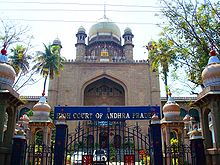
Andhra Pradesh High Court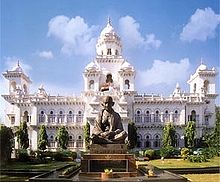
Andhra Pradesh Legislative Assembly
|
|
Economy
Hyderabad is the financial, economic and political capital of the state
of Telangana. The city is the largest contributor to the state's
Gross Domestic Product, state tax and excise revenues. Hyderabad ranks
93rd (as of 2008) in the List of richest cities in the world by GDP
(PPP) with US$60 bn and sixth in India. In terms of GDP per capita
(PPP), Hyderabad ranks 4th in India with US$6,428 and a workforce
participation of 29.55%[citation needed]. Hyderabad is ranked as the 2nd
best Indian city for doing business in the Doing Business 2011 Report
published by the World Bank Group.
Starting in the 1990s, the economic pattern of the city has changed from
being a primarily service city to being one with a more diversified
spectrum, including trade, transport, commerce, storage, communication
etc. Service industry is the major contributor, with urban workforce
constituting 90% of the total workforce.
Hyderabad is known as the city of pearls, lakes. The bangles market
known as Laad Bazaar is situated near Charminar. Products such as
silverware, saris, Nirmal and Kalamkari paintings and artifacts, unique
Bidri handcrafted items, lacquer bangles studded with stones,silk ware,
cotton ware and handloom-based clothing materials are made and traded
through the city for centuries.
Hyderabad is a major center for Pharma & Biotech with
companies such as USP, Novartis, Dr. Reddy's Laboratories, Agilent,
Biological E limited, Shantha Biotechnics, Sanofipasteur, Bharath
Biotech, GVK BIO, Matrix Laboratories, Krebs biochemicals, Magene
Lifesciences, AstraZeneca, Hetero Drugs Limited, Divis Labs, Aurobindo
Pharma Limited, Quintiles Ocimum Biosolutions, Lee Pharma, MAKRO,
Gene-Tech, Vimta Labs etc. being housed in the city. Initiatives such as
Genome Valley, Fab City and the Nano Technology park are expected to
create extensive infrastructure in bio-technology.
Like many Indian cities, Hyderabad has witnessed a
high growth in the real estate business,thanks to an
information-technology-driven boom in the 1990s and the retail industry
growth over the last few years which have spurred hectic commercial
activity. A number of mega malls have come up or are being built in the
city.Real estate demand in the suburban and rural areas surrounding
Hyderabad has gone up exponentially leading to a rapid increase in
prices over the past few years. The Confederation of Real Estate
Developers’ Association of India
(CREDAI) is quite optimistic about the coming times.
Leveraging on the trend, many property developers like Godrej Properties
, PBEL, Janapriya Properties, Ramky Estates and more have set up base in
the city leading to a rapid increase in prices over the past few
years.[41] Jubilee Hills, Banjara Hills, Begumpet and Himayath Nagar
areas are considered the posh residential areas of Hyderabad.
The retail industry in Hyderabad is on the rise. Many international and
national brands have set up retail chains here. The city has multiple
Central Business Districts (CBDs) spread across the city. There are many
major business/commercial districts from the older Charminar area to
newer Kothaguda. For the advancement of infrastructure in the city, the
government is building a skyscraper business district at Manchirevula,
near Rajendranagar with a 450 m supertall structure APIIC Tower at its
centre. Also, the Lanco Hills near Gachibowli presents the tallest
structure in India for residential and commercial purposes.
 |
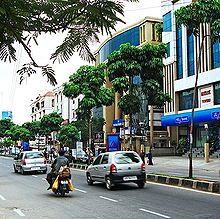 |
| Raj Bhavan Road at Somajiguda, one of the
areas in the city where urbanization is on the rise. |
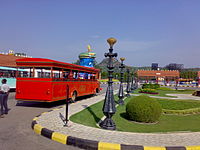 |
| |
 |
A store at Laad
Bazaar selling bangles
and jewellery. The Laadbazar and the
Charminar market area are famous for
pearls. |
|
|
Information technology industry Hyderabad has
established itself as the leading destination for IT and IT-enabled
services, BPO and entertainment industries. Many computer software
companies, software consulting firms, business process outsourcing (BPO)
firms, dealing with IT and other technological services firms have
established their offices and facilities in the city since the 1990s.
The development of a township with related
technological infrastructure called HITEC City prompted several IT and
ITES companies to set up operations in the city. An aggressive promotion
of growth in this area has led civic boosters to call the city
Cyberabad.There have been extensive investments in digital
infrastructure within the city promoting the setting up of several
campuses by a vast array of companies within the city. This list
includes several multinational corporations having established their
development centres in the city. Major areas where such campuses have
been set up are Madhapur, Kondapur, Gachibowli and Uppal. Microsoft
(with its largest R&D campus outside the US), Oracle Corporation etc.
have set up operations in Hyderabad. For a more comprehensive list of IT
companies in Hyderabad, refer to Software industry in Telangana. TCS Deccan park is one of the active branches of TCS in hyderabad. The
20th International World Wide Web Conference took place in Hyderabad.

|

Cyber Towers at Hitech City in Hyderbad

Microsoft R&D Campus in Gachibowli,Hyderabad. |
|
Education and research
Schools in Hyderabad are affiliated to either CBSE, SSLC or ICSE.
Schools are run by either state government, local governing bodies,
private individuals, missionaries or other agencies. Children in
Hyderabad schools have to study for ten years in schools, followed by
two years in junior college before becoming eligible to enroll for
graduation programme in a college. In schools the medium of instruction
is either English, Telugu or Urdu.
The University of Hyderabad was recently ranked first in Indian
subcontinent in the R&D arena.In addition to various colleges, the city
is home to three central universities, two deemed universities,
and six state universities. Colleges in Hyderabad are generally
affiliated to Osmania University. Osmania University, established in
1917, is the seventh oldest university in India and the third oldest in
South India.
Indian School of Business an international business school ranked number
12 in global MBA rankings by the Financial Times of London in 2010
established by a group of Fortune 500 CEOs in collaboration with AP
Government is also located in Hyderabad.Institute of Public Enterprise
is a premier Business School at Hyderabad and is recognized as a "Centre
of Excellence" by the Indian Council of Social Science Research (ICSSR),
Ministry of Human Resource Development, Government of India, New Delhi
for doctoral studies. IPE ranks among 'Top Government -Aided B-Schools'
by "Center for Forecasting published in Wall Street Journal 2009" and it
ranked 23rd overall India by CSR-GHRDC B-School Survey 2009.
Colleges in Hyderabad offer graduation, post graduation and doctoral
programmes in science, arts, engineering, commerce, law &
medicine,fashion. College of Engineering – Osmania University,
International Institute of Information Technology, Hyderabad, Birla
Institute of Technology & Science , Jawaharlal Nehru Technological
University, Indian Institute of Technology, etc. are some of the famous
engineering schools in Hyderabad. In addition to engineering colleges,
various institutes known as National Institute Of
Fashion Technology offer various degree course in the field of fashion,
polytechnics offer a three year course in engineering. However,this does
not lead to complete graduation.
Gandhi Medical College and Osmania Medical College are the centres of
medical education in Hyderabad. Admissions to professional colleges in
Hyderbad is through EAMCET.
Colleges and universities in Hyderabad are run by either by state
government, central government or private individuals or agencies.
NALSAR, NIPER, Potti Sreeramulu Telugu University, Maulana Azad National
Urdu University, English and Foreign Languages University, Acharya N.G.
Ranga Agricultural University, are some of the other universities
located in Hyderabad.
 |

Osmania University in
Hyderabad

IndianSchoolofBusiness

Shamirpet is home to NALSAR, BITS and Genome Valley
|
|
Research institutions
Hyderabad is home to various CSIR and other public sector research
institutes such as Indian Institute of Chemical Technology (IICT),
Centre for Cellular and Molecular Biology(CCMB), Centre for DNA
Fingerprinting and Diagnostics CDFD, National Geophysical Research
Institute(NGRI), National Institute of Nutrition(NIN), Indian
Immunologicals Limited(IIL),Institute of Genetics and Hospital for
Genetic Diseases (IGHD), Center For Food Technological Research
Institute(CFTRI),Central Institute for Medicinal and Aromatic
plants,(CIMAP), National Mineral Development Corpation(NMDC), IRISET for
railway signal engineering and ICRISAT. Further, Defence Research and
Development Organisation (DRDO) labs like ANURAG, DMRL, DRDL and DERL
are facilitated with research centres in Hyderabad to develop
communication and radar systems and for the Integrated Guided Missile
Development Programme (IGMDP). Nuclear energy sector has a large
presence with three organisations under Department of Atomic Energy
(India) including the Atomic Minerals Directorate for Exploration and
Research (AMD), Nuclear Fuel Complex (NFC) and Electronics Corporation
of India Limited (ECIL).
Hyderabad hosted the International Congress of Mathematicians (ICM),in
August 2010. More than 2500 Mathematicians from all over the world had
participated in this conference.Hyderabad is also hosting the
International World Wide Web (WWW) conference in the first-half of 2011.

|
|
|
Transport
Roads
Hyderabad is connected to the rest of the country by
National Highways—NH-7, NH-9 and NH-202. Hyderabad is also well
connected to the remaining parts of the state. Like other cities,
Hyderabad suffers from traffic congestion. Completion of the Inner Ring
Road and construction of the Outer Ring Road encircling Hyderabad city
is also underway and is touted to make travel in the city easier. Many
flyovers and underpasses are also being constructed to ease traffic
congestion in the city.The Telangana State Road Transport
Corporation runs a fleet of 19,000 buses, the largest in the world.
Hyderabad has the third largest bus station facility in Asia, with 72
platforms for 89 buses to load passengers at a time. Officially named as
the Mahatma Gandhi Bus Station, it is locally known as the Imlibun Bus
Station, Jubilee Bus Station at Secunderabad runs buses to various parts
of the state and to some parts of South India.

Local transport
The yellow colored Auto Rickshaw usually referred to as an auto, is the
most widely used transport service and has flag down minimum fare of Rs
12 for first 1.5 km and then Rs 7 per km. Radio Taxis and cabs by
private players have provided an easy travel in the city.

Rail
Railways were first introduced in the city in the year 1869 with the
commencement of Secunderabad–Wadi line of Nizam's Guaranteed State
Railway. Secunderabad Railway Station is the headquarters of the South
Central Railway zone of the Indian Railways and is the largest railway
station serving Hyderabad. The other major railway stations serving the
city are Hyderabad Deccan Station (Nampally), Kachiguda Railway Station
and Begumpet Railway Station. These stations provide connectivity within
the city and the rest of the country.

Local Trains
Hyderabad has a light rail transportation system known as the MultiModal
Transport System (MMTS) which runs local services providing connectivity
mainly to the IT corridor and Secunderabad. MMTS Phase 2 is expected to
complete by 2012. The SCR plans to incorporate more rakes.
Hyderabad Metro, the proposed rapid transit for the city is executed by
L&T, and is expected to operate 4 lines by 2014.

AirThe international air port at
Shamshabad, is a major airport in India and paved its way up in
to the top five airports of the world list by ACI.
There has been an unprecedented increase in
the number of passengers leading to increased air traffic The
Airport at Begumpet was unable to cope up with the situation and
was shut down on 2008-03-22. The new Rajiv Gandhi International
Airport was opened in March 2008 by Sonia Gandhi at Shamshabad,
southwest of the city The airport has the longest runway in
India and caters to the high passenger and cargo volumes it
experiences. It is a hub for Jet Lite, SpiceJet and IndiGo. On
16 February 2010, Hyderabad International Airport was ranked
fifth Best Airports Globally by Airports Council International.
The airport has been named as the number one airport in 5–15
million passenger category by the Airport Council International
in a worldwide conducted survey. 29 October 2009, GMR Hyderabad
International Airport Limited (GHIAL), has bagged the Center for
Asia Pacific Aviation’s (CAPA) newly instituted award in the
category, “Best Airport Environmental Performance of the Year”.
Hyderabad international airport has been named amongst the
world's top five in the annual Airport Service Quality (ASQ)
passenger survey along with the ones at Seoul, Singapore, Hong
Kong and Beijing. The airport is the largest in terms of area
and will provide world-class facilities among all airports in
India. It is said to There are flights to many destinations,
both domestic and international from this airport.
The PV Narasimha Rao Expressway was
constructed at an elevated level from Mehdipatnam to
Rajendranagar along with an underpass and trumpet interchange
for providing dedicated high speed travel to the airport. It is
the longest flyover in India. There are three wide roads leading
to the new airport from the city and modern taxis and buses can
shuttle passengers between the city and the airport. The Nehru
Outer Ring Road serves as an expressway between Gachibowli and
Shamshabad. The other airports located here are Dundigul Air
Force Academy, Nadirgul Airport and Hakimpet Airport.


|
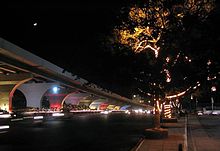
Secretariat Flyover lit
up at night.

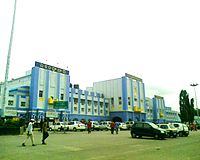
The Secunderabad Railway Station

Rajiv Gandhi International Airport, Shamshabad |
Culture
Historically, Hyderabad has been the city where distinct
cultural and linguistic traditions of North India and South
India meet. Hyderabadis, as residents of the city are
known, have developed a distinctive culture which is a mixture
of Hindu and Muslim traditions. A typical Hyderabadi could be
either a Telugu or a Urdu-speaking person that has decided to
make Hyderabad his/her home.
Women of all cultures and faiths in Hyderabad typically wear
either the traditional Indian dress, the sari, or, increasingly,
the Salwar kameez especially among the younger population. The
traditional Hyderabadi garb for females are the Khara Dupatta,
the Salwar kameez and the Burqa (religious). For males the
traditional garb is the Sherwani. This is one of the more
visible cultural attributes of Hyderabad.
One of Hyderabad's public carnivals is the
annual immersion of Lord Ganesh idols after the 10 day Ganesh
Chaturthi celebrations on Ananta Chaturdashi (locally known as
the Ganesh Nimajjanam). Bonalu is a vernacular festival that is
celebrated with great fervour.The Muslims fast for 30 days
during their holy month of Ramzan, observed in piety and
charity,and celebrated at the end by Eid ul-Fitr, three days of
festivities with greetings and joy by everyone. At Eid a
traditional sweet is made known as Sheer Qorma. An annual
procession takes place every 10th Muharram (1st month of Islamic
calendar)by the Shia Muslims at Charminar where participants
mourn through self-flagellation.

Cuisine
Hyderabadi cuisine is a blend of traditional South Indian,
Mughal, and Persian cuisine. Hyderabadi Biryani is an iconic
dish of the region. Other native preparations include Qubani ka
meetha, Double ka meetha, Phirni, Nahari Kulche also known as
paya and Haleem (a meat dish traditionally eaten during the
holy month of Ramzan), Kaddu Ki Kheer (a sweet porridge made
with sweet gourd), Sheer Qorma (a sweet liquid dish cooked with
vermicelli and milk), Mirchi ka saalan, Bagaare baigan, Khatti
dal, Khichdi and Khatta, Til ki chutney, baigan ki chutney, Til
ka khatta, Aam ka achaar, Gosht ka achaar, Peosi (a sweet
prepared with egg whites and milk), Shahi tukde, Kheema aaloo
etc.
On street-corners are Irani caf�s that offer
Irani chai, Irani samosa and Osmania biscuit.
The sweets are known for their ghee-based
items. Famous sweet shops include the traditionally made.
G.Pulla Reddy, Hammedi Confectioners, Rami Reddy sweets and
Karachi Bakery.
Italian, Mexican, Chinese and Continental
cuisine are all popular in the city along with typical Andhra
and other South Indian cuisine. Pubs are also getting popular in
Hyderabad.

|
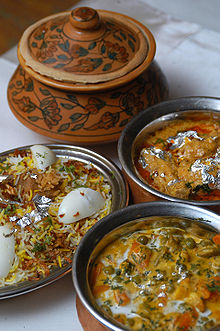 Hyderabadi Biryani
Hyderabadi Biryani |
|
Sports
The 2003 Afro-Asian Games was the second largest sports event held in
India. Shown here is the Opening Ceremony at the GMC Balayogi Stadium.
Cricket and Field hockey are the most popular sports in the city.
Hyderabad Sultans won the inaugural Premier Hockey League championship
in 2005. The city took pride in hosting National Games and Afro-Asian
Games. The 4th Military World Games with participation from 110
countries was held in Hyderabad in October 2007. Hyderabad 10k Run is a
marathon event conducted every year.
The earliest stadium built in the city is the Lal Bahadur Shastri
Stadium. Formerly known as Fateh Maidan, it was, till recently, the
city's only stadium that could conduct International cricket matches.
The first cricket match played here was on 19 November 1955. The stadium
is currently being used to conduct ICL matches. The new Rajiv Gandhi
International Cricket Stadium at Uppal has a capacity of approximately
55,000 spectators and is being enhanced to have world class facilities.
It houses an ultra-modern gymnasium along with a swimming pool. It has
been recently accorded Test match status by the International Cricket
Council.
Noted sports persons of International stature from Hyderabad include
Ghulam Ahmed, M L Jaisimha, Mohammed Azharuddin, VVS Laxman,
Venkatapathy Raju, Shivlal Yadav, Arshad Ayub, Noel David (Cricket),
Syed Abdul Rahim,Sania Mirza (Lawn Tennis), Pullela Gopichand, Jwala
Gutta, Saina Nehwal, Chetan Anand (Badminton), Mukesh Kumar (Hockey).
Hyderabad's Deccan Chargers franchise in the Indian Premier League was
bought by Deccan Chronicle for USD 107 million. Deccan Chargers won the
title for the year 2009. The city also has an ICL team named Hyderabad
Heroes.
The city houses the Swarnandhra Pradesh Sports Complex, the G.M.C.
Balayogi Athletic Stadium at Gachibowli for hockey and football and a
sophisticated Velodrome for cycling at Osmania University. The city has
state-of-the-art venues for gymnastics, archery and sepak takraw,
shooting at Saroornagar Indoor Arena and University of Hyderabad
respectively. The Aquatics Complex Stadium at Gachibowli, with a
capacity of 3000 spectators hosts swimming, diving, water polo and
synchronized events. Kotla Vijay Bhaskar Reddy Indoor Stadium is a
multi-purpose stadium with a capacity of 2500 spectators and wooden
flooring with temperature control. SAAP Tennis Complex has a central
court that holds 5000 spectators and has seven courts with synthetic
surface. Water games like rowing, yachting, kayaking and canoeing are
conducted at Hussain Sagar lake. The city also has five Go-Karting
tracks and a Paint Ball Field. There are venues for table-tennis,
basketball, equestrianism, boxing, weight-lifting with world class
facilities. Hyderabad is fast becoming the hub of motosports events in
AP, the Andhra Pradesh motor sports club (APMSC) which was started way
back in 1977, has been instrumental in organising popular events like
the Deccan 1/4 Mile Drag, TSD Rallies, 4x4 Off road in the recent past
which received participation from all corners of India.
Hyderabad has hosted the 2003 Afro-Asian Games at the G.M.C. Balayogi
Athletic Stadium in which India won 19 gold medals and made second right
behind Chine.
The city is well known for Horse racing. The Hyderabad Race Club
formerly known as the Nizam Race Club is located at Malakpet. The
Hyderabad race club attracts jockeys from all over the country by
conducting various derbys/events here. The Deccan derby, a popular
annual event is a regular feature here. The winter races also were
conducted here recently. Badminton events take place at the Kotla Vijay
Bhaskar Stadium and also at Gachibowli stadiums, and also played by
youth and veterans in locality parks.

(Courtesy www.wikipedia.org) |
 Rajiv Gandhi International Cricket Stadium, Uppal
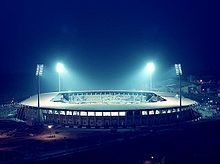
G.M.C. Balayogi Athletic Stadium
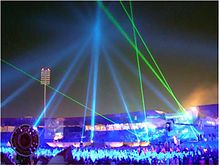
The 2003 Afro-Asian Games was the second largest sports event held in
India. Shown here is the Opening Ceremony at the GMC Balayogi Stadium. |
|
|
|
![]()




















 Hyderabadi Biryani
Hyderabadi Biryani

